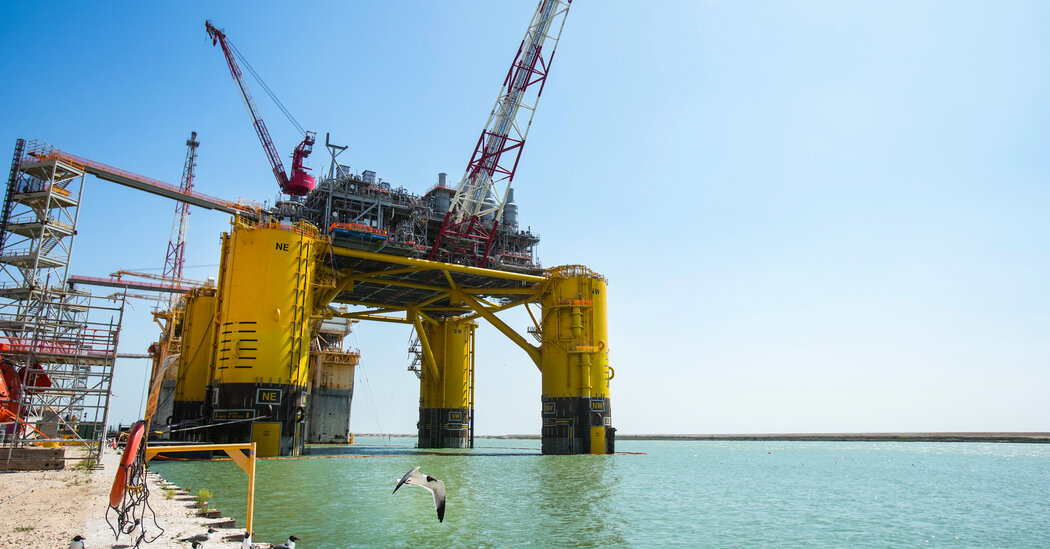The Biden administration announced Friday it would lease a handful of spots in the Gulf of Mexico to oil companies for drilling over the next five years, a move that is likely to anger both climate activists and the fossil fuel industry.
The administration said oil and gas companies would be able to drill in just three new areas in the Gulf between 2024 and 2029, the smallest number of lease sales offered since the federal drilling program began decades ago.
Under a new law, the government must offer leases for oil drilling before it can invite developers to build wind farms in federal waters. Producing clean electricity from wind turbines is one of President Biden’s top priorities as he tries to reduce the fossil fuel pollution that is dangerously heating the planet.
Deb Haaland, the Interior Department secretary, said in a statement that the plan “sets a course for the department to support the growing offshore wind industry and protect against the potential for environmental damage and adverse impacts to coastal communities.”
The five-year plan is significant because the government cannot conduct any lease sales that are not specified in the plan, and the time frame is such that it determines the actions of a future administration.
The oil industry, which had pressed for unfettered access to waters around the United States, warned that limiting its opportunities to drill would force the country to increase oil imports from countries with lax environmental standards.
Climate advocates want the administration to end new leasing altogether. Scientists around the world have said that nations must stop new fossil fuel projects to prevent the most cataclysmic impacts of global warming.
“This decision is beyond disappointing,” Beth Lowell, the vice president of Oceana, an environmental group, said in a statement. “Expanding dirty and dangerous offshore drilling only exacerbates the climate catastrophe that is already at our doorstep.”
As a candidate, Mr. Biden had promised “no new drilling, period” on public lands and in federal waters. But time and again, he has been compelled by courts or Congress to approve new drilling.
Emissions from burning fossil fuels extracted from federal lands and waters account for almost 25 percent of the country’s greenhouse gas emissions, according to the U.S. Geological Survey.
The 1953 Outer Continental Shelf Lands Act requires a plan to be updated every five years that lays out where the government would lease its offshore mineral, gas and oil resources, subject to environmental review.
The last version of the plan was finalized under President Barack Obama and expired in 2022. President Donald J. Trump proposed opening virtually all United States waters to oil and gas drilling but then declared a moratorium off the coasts of Florida, Georgia and South Carolina after Republican leaders in those states said they feared drilling could mar beaches and harm tourism. His plan was never finalized.
Mr. Biden’s plan will undergo a 60-day congressional review before it can be implemented.
The three areas to be leased are in the western and central Gulf of Mexico. According to the Interior Department, the government chose sections where oil and gas facilities already exist. The Gulf is the primary source of offshore oil and gas in the United States.
The agency said that limiting potential leases put the plan in line with President Biden’s goal for the United States to stop adding greenhouse gases to the atmosphere by 2050.
Erik Milito, president of the National Ocean Industries Association, which represents offshore oil, gas and wind companies, said that limiting drilling not only harmed the economy but also could hurt efforts to fight global warming because gas could replace coal, the dirtiest of the fossil fuels.
“This not only compromises our energy security and economic well-being but also hampers our progress in reducing emissions and addressing climate change,” Mr. Milito said.
However, methane, a far more potent greenhouse gas than carbon dioxide in the short term, frequently leaks from natural gas production and is a growing concern among climate scientists.
Republicans and oil industry leaders are expected to challenge the new five-year plan in court, although that may prove difficult because the Outer Continental Shelf Lands Act does not require a minimum number of lease sales.
Still, the Inflation Reduction Act of 2022 does require oil and gas lease sales as a condition of leasing waters for wind farms. Before it can allow wind farms to be built in federal waters, the government must first offer at least 60 million acres offshore in the previous year for oil and gas leasing. The provision was included in the law by Senator Joe Manchin III of West Virginia, a fossil-fuel-friendly Democrat.
Mr. Biden has set a goal of deploying 30 gigawatts of offshore wind by 2030, enough to power 10 million homes. The administration said that it had already approved four commercial-scale offshore wind projects and that it expected to review at least 16 more offshore wind projects by 2025. Together, they would produce more than 27 gigawatts of electricity, it said.
Environmental groups have argued that the Biden administration has consigned Gulf communities to health impacts from exposure to oil and gas drilling, refineries, petrochemical plants and other related facilities that crowd the coastal states of Louisiana, Texas, Alabama and Mississippi.
“The Gulf is the sacrifice zone of America and people of this region are so tired of being sacrificed,” said Christian Wagley, an organizer with Healthy Gulf, a nonprofit group based in New Orleans.











